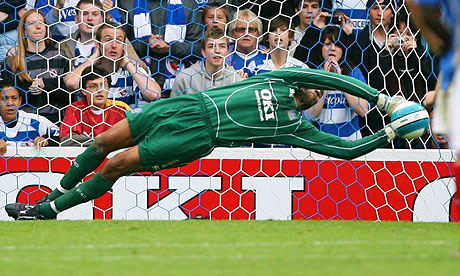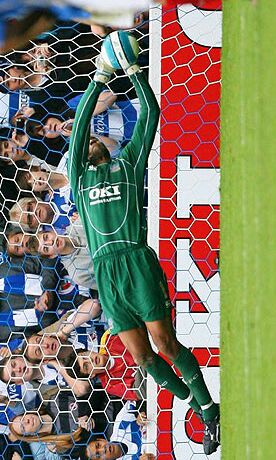
|
"Outstanding keeper instruction. This is a must for goalkeepers and coaches." —Ottawa Internationals S.C. web site, Ottawa, Canada |

|

|
Top |
Goalkeeping Tips, Tidbits and Random Thoughts
An athlete talking to themsleves during competition is hardly a new phenomenon.... The talk does not have to be vocal. By merely thinking you are talking to yourself and sending a message.
-- Tony DiCicco, Goalkeeper Soccer Training Manual
If you have a question, comment or rebuttal you'd like to see addressed here, send me email. I will post your mail to the blog at my discretion unless you specify otherwise.
Forward in all directions!
Myself and other goalkeeper coaches preach stepping forward at an angle to make a diving save. Sometimes, when a keeper I'm training makes a mistake directly attributed to diving backwards, I'll jokingly say: "That's reason number 17 to dive forward!" While there may not be 17 reasons, there are at least a half-dozen advantages of stepping forward into the dive:- More speed and extension. The human body is designed to go forward, not backwards. A forward step allows the stepping leg to generate more speed and power, and potentially get to a ball that might have gotten by if going backwards.
- Better catching angle. The "perfect" dive, one that is perpendicular to the flight of the ball, gets the hands in the optimum angle to make the catch. Any other angle means the ball is not coming square onto the hands, making it more difficult to catch.
- Better angle of deflection. If the ball isn't held, a forward angle has a much better chance of propelling the ball away from goal or around the post. A backward angle may mean just pushing the ball into the side netting.
- Covering more of the goal. Diving forward takes the keeper away from the line, which has the result of covering more of the goal mouth.
- Going away from the post. A backwards dive can put the keeper at risk of colliding with the goalpost. The post will usually win. A forward dive takes the keeper away from potential collisions.
- Room for error. Just like any other catch, we want to get the hands forward so that if there is any error in judgment, we have some leeway to adjust. A forward dive allows for that.
Labels: Diving
The easiest save
I found a great picture over at The Guardian of David James making a diving save with excellent form:
He's at full stretch, but his head, eyes and hands are aligned, he's focused on the ball with two hands securely on it.
Our goal as keepers is to make every save look like the easiest save possible. The easiest save is one that is right in front of us. So a big part of why we dive is to get our body behind the ball as much as possible. If you plucked a keeper with good form out of mid-air, he should look like he is saving an easy ball in front of him:

The only difference is that he is horizontal and several feet off the ground.
Labels: Diving